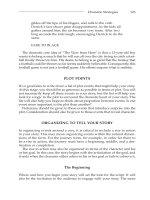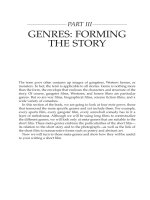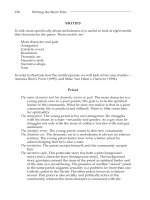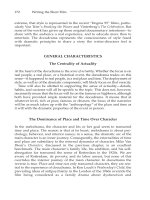Tài liệu Writing the short film 3th - Part 2 ppt
Bạn đang xem bản rút gọn của tài liệu. Xem và tải ngay bản đầy đủ của tài liệu tại đây (116.21 KB, 7 trang )
CONTENTS
ACKNOWLEDGMENTS ix
INTRODUCTION 1
PART I Fundamentals: Breaking Ground 7
Chapter 1 STORYTELLING IN GENERAL 9
Chapter 2 TELLING A STORY IN IMAGES 17
Chapter 3 USING SOUND TO TELL THE STORY 29
Chapter 4 DISCOVERING AND EXPLORING A MAIN 37
CHARACTER
Chapter 5 TELLING THE DRAMATIC STORY 47
Chapter 6 WRITING AN ORIGINAL SHORT SCREENPLAY 65
Chapter 7 ON REVISION: SUBSTANCE AND STYLE 79
PART II Moving Forward: Writing Strategies 87
Chapter 8 THE NEED FOR STORYTELLING 89
Chapter 9 VISUALIZATION STRATEGIES 101
Chapter 10 DRAMATIC STRATEGIES 113
Chapter 11 CHARACTERIZATION STRATEGIES 127
Chapter 12 MORE ON DIALOGUE STRATEGIES 141
vii
FM.qxd 9/27/04 6:12 PM Page vii
PART III Genres: Forming the Story 151
Chapter 13 THE MELODRAMA 153
Chapter 14 THE DOCUDRAMA 171
Chapter 15 THE HYPERDRAMA 187
Chapter 16 THE EXPERIMENTAL NARRATIVE 205
PART IV New Directions 221
Chapter 17 THE OPPORTUNITY FOR RENEWAL 223
APPENDIX A Short Short Screenplays 233
Vincent, by Gert Embrechts 235
Sob Story, by Matthew E. Goldenberg and
Michael Slavens 241
Pigeon, by Anthony Green 249
APPENDIX B
Short Screenplays 257
Another Story, by Lisa Wood Shapiro 259
The Lady in Waiting, by Christian Taylor 270
Sleeping Beauties, by Karyn Kusama 297
The Wounding, by Susan Emerling 308
Dead Letters Don’t Die, by Anais Granofsky
and Michael Swanhaus 323
INDEX 345
viii Writing the Short Film
FM.qxd 9/27/04 6:12 PM Page viii
ACKNOWLEDGMENTS
PAT COOPER
I would like to thank Ken Dancyger for his provocative
ideas, easy wit, and exemplary patience throughout our
partnership on this project. He is a most gracious collabora-
tor and a valued friend. I would also like to thank Mary
Carlson for her perceptive comments on the first draft.
KEN DANCYGER
The notion of writing a book about scripting short films
began with Pat Cooper. I have to thank her for her enthu-
siasm, her insights, and her commitment to students. And
I thank her for bringing me into this project. She is a great
friend and collaborator. At New York University, I’d like
to thank Christina Rote and Delliah Bond, who assisted
me in the preparation of the manuscript. Finally, I’d like to
thank my wife, Ida, for her intelligent critiques of the
manuscript at all phases.
On this latest edition we would like to thank our new
scriptwriters—Gert Embrechts, Matthew Goldenberg,
Michael Slavens, and Anthony Green—for allowing us to
include their screenplays. We would also like to thank
Elinor Actipis at Focal Press and Trevor MacDougall at
Kolam, Inc. for their excellent and thorough edit.
ix
FM.qxd 9/27/04 6:12 PM Page ix
FM.qxd 9/27/04 6:12 PM Page x
INTRODUCTION
This book is primarily intended for film and video students or independent
video- and filmmakers who are faced with the necessity of writing a short
narrative script. For our purposes, we consider a short film to be one of 30
minutes or less, as films longer than that usually need a secondary, or minor,
plot-line to sustain audience interest and, in addition, are much less likely to
be eligible for festivals or suitable to be shown as “portfolio” work.
Although our main focus is on the short narrative film, we intend to
demonstrate the ways in which each short form has borrowed freely from
the others. It is important that less-experienced screenwriters realize that,
even when the scripting of a narrative, documentary, or experimental film
proceeds in an informal way—using improvisation, for example—the film
itself still needs a purpose and shape to make a coherent whole. This is true
even of stories that may concern themselves primarily with form, or form as
context, as is frequently the case with postmodern films or videos.
THE EVOLUTION OF THE SHORT FILM
At the outset of film being created as an art, all films were short. Indeed,
until 1913, all films were 15 minutes long or less. Only after the Italian film
epics had influenced D. W. Griffith to produce Judith of Bethulia did the
longer form come to be the norm.
Although feature film eventually became the predominant form, comedy
shorts, from Mack Sennett to the Bowery Boys, were produced until the suc-
cess of television in the 1950s. Serialized films were also essentially shorts,
characterized by an incident or catalytic event, which led to a character
responding and other characters resisting that response. The films presented
melodramatic protagonists and antagonists: the Battle at Elderbrush Gulch, by
D. W. Griffith, and The Tramp, by Charlie Chaplin, illustrate the common
1
Intro.qxd 9/27/04 6:13 PM Page 1
2 Writing the Short Film
characteristics of these short films. An ordinary character, caught up in
extraordinary events, succeeds in overcoming those events and his or her
antagonists, in an exciting, astonishing fashion. One of the most famous
short films ever made was both a response to the conventions of narrative
film in the ‘20s and an experiment influenced by ideas being explored in the
visual arts (surrealism) and in the particulars of Spanish Catholic theology.
That film, Un Chien d’Andalou, was the product of a collaboration between
Salvador Dalí and Luis Buñuel. No other short film still succeeds in shock-
ing and confusing audiences as does the Buñuel-Dalí collaboration, and no
other film has shown such shocking individual images paired with so little
concern for overall meaning.
But for our purpose in this book, Un Chien d’Andalou—because it is so
challenging to the narrative conventions often associated with film—
remains an experiment in form rather than a case study for scripting the suc-
cessful short film. Nevertheless, the audacity of the film cemented a
relationship between film and the visual arts and ideas closely tied to art (for
example, surrealism and the growing importance of psychotherapy in the
visual arts); this has become a continuing source of short films, from the
work of Man Ray and Maya Deren to the more contemporary work of Stan
Brakhage, Michael Snow, and Joyce Wieland.
Other developments in the short film coalesced around the documentary
work of John Grierson and his colleagues Basil Wright and Edgar Ansty at
the Empire Marketing Board in England, and around the work of Pare
Lorentz and Willard Van Dyke in the United States. The films these film-
makers produced were issue-driven, encouraging government intervention
in the economy in the United States or promoting the benefits of government
policy in the United Kingdom. None of these films revolved around a par-
ticular event or used a protagonist or an antagonist; their structures are, for
the most part, essay-like rather than narrative. The drama of real-life issues
close to a particular political consciousness motivated these filmmakers, and
their films were often labeled propaganda.
Yet another offshoot of the short film, this time from the commercial stu-
dio of Walt Disney, was the animated short, intended to be shown with fea-
ture films in theaters. These 5- to 8-minute films had a protagonist (often a
mouse, a rabbit, or a wolf) with a strongly defined character and a particu-
lar goal. The story would unfold when the character’s efforts to achieve a
goal were thwarted by a situation or antagonist. The character’s struggle to
achieve his or her goal made up the story of the film. These films abounded
in action and conflict, the dramatic values yielding laughter at rather than
sympathy for the main character and his or her struggle. They were very
successful, and their pattern of narrative plotting and development of char-
acter set the tone and pace for an even shorter film form—the commercial.
Whether they last 3 minutes or 30 seconds, commercials often tell a story
Intro.qxd 9/27/04 6:13 PM Page 2
Introduction 3
based on the pattern established in the animated shorts, which used estab-
lished narrative forms—the tale, the fable, the journey—to convey, and at
times to frame, the narrative. By 1960, filmmakers in Europe had begun to
use the short film as a means of entry into the production of longer films. In
Poland, Roman Polanski directed Two Men and a Wardrobe (1958). In England,
Lindsay Anderson directed O Dreamland! (1954), and Richard Lester, The
Running Jumping and Standing Still Film (1959). In France, Jean-Luc Godard
directed All Boys Are Called Patrick (1957), and François Truffaut directed Les
Mistons (1958). In this period, Alain Resnais directed his remarkable Night
and Fog (1955), about Auschwitz; Federico Fellini directed Toby Dammit
(1963), and Norman McLaren directed his classic antiwar short Neighbors
(1952). Only McLaren stayed with the short films; all the others moved on to
distinguished careers as international filmmakers and continued their work
in the long form.
This transition from short film to feature also seems to be the pattern for
students in American film departments. Since the 1960s, these schools have
produced distinguished alumni who began their work in the short form
and then moved to the long: Oliver Stone, Martin Scorsese, Chris
Columbus, M. Night Shyamalan, and Martin Brest on the East Coast, and
Francis Coppola and George Lucas on the West Coast are among the most
successful graduates of the film schools. Lucas’s THX 1138 (1966) and
Scorsese’s It’s Not Just You, Murray! (1964) are among the best student films
ever made, though their work at the time was no more than apprenticeship
for the long film.
While it is true that there are filmmakers in the experimental and docu-
mentary area who continue to work in the short form, more and more film-
makers in these areas are moving to the long form as well (Bruce Elder or Su
Friedrich in the experimental film genre, and the work of Ross McKelwee and
Barbara Kopple in the documentary, for example). The short, at least in North
America, is more and more an economic necessity for the student filmmaker
and the novice professional, and while there are still short films produced in
the educational corporate sectors, they are far fewer than in the past.
In Europe, however, the short film remains a viable form of expression,
one supported in large part by cultural ministries. Magazines devoted to
short films as well as festivals devoted exclusively to the form assure, at least
for the medium term, that it will continue to thrive. Internationally, film
schools have provided continuing support for the short film. The interna-
tional organization of film schools, CILECT, has held a biannual student film
festival focused on the European schools, and an annual student festival has
been sponsored by the Hochschule in Munich. Another important biannual
festival is the Tel Aviv Film Festival. All of these festivals are related to the
CILECT organization and focus on the work of students in member schools.
The Oberhausen Festival in Germany and the Clement-Ferrand Festival in
Intro.qxd 9/27/04 6:13 PM Page 3









